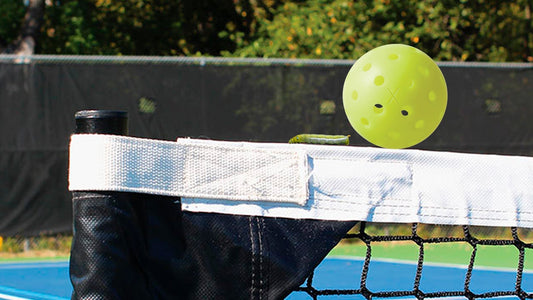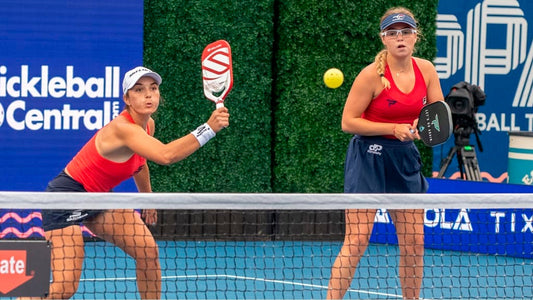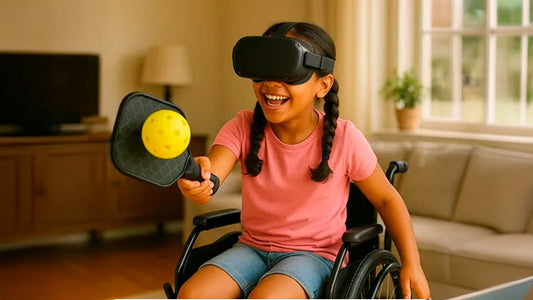
Playing Pickleball Indoor Versus Outdoor
Share
“Adaptability is about the powerful difference between adapting to cope and adapting to win.” – Max McKeown
Pickleball is one of the fastest-growing sports globally, and its versatility is a big part of its appeal. Whether you’re playing under the sun on an outdoor court or indoors with controlled conditions, each setting offers unique challenges and opportunities. In this blog, we’ll break down the key differences between playing pickleball outdoors versus indoors and how to adapt your game for each environment.
Court Surface
The type of court surface can significantly impact how the ball bounces and moves during the game.
-
Outdoor Courts:
Outdoor pickleball courts are typically made of asphalt or concrete and may have an acrylic coating. These hard surfaces often have a rougher texture to provide traction, which can slightly reduce ball speed and create more consistent bounces. -
Indoor Courts:
Indoor courts are often gym floors made of wood, synthetic materials, or tile. These smoother surfaces can result in faster ball speeds and lower, less predictable bounces. -
Adapting Your Game:
When playing outdoors, be prepared for higher and more consistent bounces. Indoors, focus on quicker reactions and adjusting to faster-paced play.
Environmental Factors
Playing outdoors introduces environmental elements that can influence the game, while indoor play provides a controlled environment.
- Outdoor:
- Wind: Wind can affect the trajectory of the ball, making it harder to predict where it will land. Strong gusts can be especially challenging during serves and lobs.
- Sun: Bright sunlight can cause glare and make it difficult to track the ball, especially during high lobs or smashes.
- Temperature: Extreme heat or cold can impact not only player stamina but also the performance of the ball and paddle.
- Indoor:
- No Weather: Indoor play eliminates wind, sun, and temperature concerns, providing consistent conditions.
- Lighting: While indoor lighting is stable, it can sometimes cause glare or shadows depending on the setup of the gym or facility.
- Adapting Your Game: Outdoor players should develop strategies to manage wind and sun, such as aiming lower during serves and wearing sunglasses or a hat. Indoors, focus on adapting to the artificial lighting and the faster pace of play.
Ball Type
The type of ball used in pickleball varies between outdoor and indoor games.
- Outdoor Balls: Outdoor pickleballs are harder, heavier, and have smaller holes to minimize the impact of wind. These balls tend to move faster and can be harder to control during fast-paced rallies.
- Indoor Balls: Indoor pickleballs are lighter, softer, and have larger holes, making them easier to control but slightly less durable. They produce less noise and are better suited for smooth indoor surfaces.
- Adapting Your Game: Practice with both types of balls to get a feel for their differences. Adjust your power and placement when switching between indoor and outdoor balls to maintain precision.
Noise and Ambiance
The overall ambiance of indoor and outdoor courts can affect the experience of playing pickleball.
- Outdoor: Outdoor play often comes with natural sounds, such as birds, wind, and nearby activities, which can add to the enjoyment but also create distractions.
- Indoor: Indoor environments can amplify noise from paddles, balls, and players, making it a louder and more intense setting.
- Adapting Your Game: Outdoors, focus on tuning out external distractions to stay in the zone. Indoors, consider using earplugs if the noise level becomes overwhelming.
Shoe Choice
The court surface and conditions influence the type of shoes you should wear.
- Outdoor: Durable shoes with non-slip soles designed for outdoor surfaces are essential. Look for footwear that provides traction and stability on rough or uneven ground.
- Indoor: Indoor courts require non-marking soles to protect the flooring and ensure grip. Lightweight shoes with good lateral support work best for indoor play.
- Adapting Your Game: Invest in separate pairs of shoes for indoor and outdoor play to ensure optimal performance and comfort in both settings.
Game Dynamics
The environment influences the pace and style of play.
- Outdoor Play: Outdoor games tend to be more physically demanding due to weather conditions and the larger impact of wind on ball placement. Strategies often involve more thoughtful placement and managing the elements.
- Indoor Play: Indoor pickleball is generally faster and more intense, with fewer external variables. Players often focus on quick reflexes, precise shots, and speed.
- Adapting Your Game: Outdoors, develop patience and focus on shot accuracy to counteract environmental challenges. Indoors, work on reflex drills and fast exchanges to keep up with the pace.
Game Point
Whether you’re playing outdoors in the fresh air or indoors in a controlled environment, pickleball is a sport that adapts to its surroundings. Each setting brings its own challenges and advantages, and mastering both can make you a more versatile and confident player.
By understanding the differences in court surfaces, environmental factors, ball types, and gameplay dynamics, you’ll be ready to excel wherever you play. So, grab your paddle, pick your court, and enjoy the game—indoors or out!
See you on the courts!



